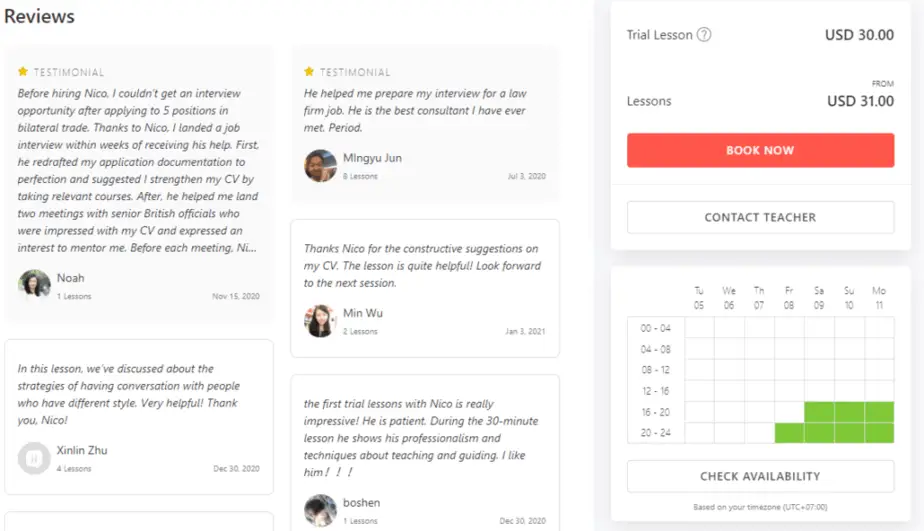Although English is only the third most spoken on the planet, it is: the most spoken second language, the language of the internet and is a passport to success in the global media, entertainment and financial worlds. It is no wonder then that online conversational English classes are in high demand.
Teaching conversational English online offers a golden opportunity to any native speaker, and fluent non native speaker who is tech savvy enough and has the personality and drive to earn anything from a few dollars/hour to around $30/hour with complete location independence.
The beauty of teaching conversational English online is that there is minimal preparation required and dare I say not as much skill required as traditional teaching of a subject. At its core is the fact that students basically just want to speak English with a native speaker and get a bit of feedback on how to improve.
Let’s take a look more closely at how to go about doing this to both help students effectively and make money for yourself.
How To Teach Conversational English Online
Let’s go through this in detail and put some meat on the bones!
STEP 1: Create teacher profiles
There are lots of places you can do this and it pays to try out a few different ones at first. The reason being is that they all tend to ebb and flow in their popularity with students at different times and they each have their own set of requirements which may restrict you somewhat.
For example, some of them want you to teach a certain amount of classes at ‘peak times’, some sites seem to attract students from certain parts of the world more than others, and some websites pay you your money in different ways and at different times.
So, you really do need to read the small print first and I recommend you sign up for a few different ones and see which you prefer the most.
Here are the best community teacher websites:
Italki (My personal favourite)
STEP 2: Upload a video, pictures and a blurb outlining your offer
It is imperative to present yourself as well as you can in your teacher profile. Factors such as, what your accent is/where you are from, what your interests and subject specialisms at school/university are/were become important factors as well as how your photo actually looks. Who wants a scary looking teacher!?
Yes, a nice smiley photo and a cheery video emphasizing your personality and enthusiasm for what you are doing can go a long way in this market place. In fact, it wouldn’t hurt to think of it as a ‘tinder for teachers’ kind of scenario: if you don’t look interesting and appealing then you aren’t going to get clicked on!
STEP 3: Be ready to provide enthusiastic trial classes
Just as with any real life language school, students expect to be able to try before they buy. Typically a student browsing who thinks you can help them will book a 20 minutes trial lesson.
Now, this is really important!
Don’t approach these trial lessons half-heartedly just because you may not be getting much money if anything for them. You usually get a prorated hourly rate which might feel like peanuts, but you must see this as the beginning of the relationship with a new student and not just twenty minutes to get through.
Here is what you need to get through in the twenty minute trial lesson. You are going to need to find out this information from the student:
20 Minute Trial Lesson Format
- Why are they learning English?
- What specific situations are they practicing for?
- Are there any significant future events they are targeting?
- What are their general interests and passions?
- How much time are they willing to dedicate to learning English
- Is it just conversation they want or do they want other skills too?
- What is their work/study situation?
- Can you find about a little about their family and close friends?
As you work through these questions in a friendly manner you will start to build a picture of them and if you can, make notes on a Google doc created just for them.
If this does not take the entire twenty minutes, which it probably will, then I recommend that you do a short role play of a situation they have just told you that they are looking to improve in. This will show them that you are listening to their needs and that you know how to prepare them for this situation.
If you spot any glaring errors that you are confident in addressing then do so but deliver it in a positive way. You might say something like: ‘next time you might want to say xyz, as it just sounds a little more natural.’
Wrap the lesson up by telling them at least three things they are doing well. For example, I might comment on their pronunciation, use of vocabulary, or how natural they sound. You want them to feel positive about you.
Finally, I will show them the plan of lessons that you devised for them. It is even better if you have already written this down on the google doc so that you can immediately screen share it with them.
It should contain a list of 6-10 lesson ideas/topics you think you could deliver to them focusing on role plays, discussion activities and debates. Ask the students what they think and make any changes before finishing the call.
Don’t pressure them into making a decision as to whether they want to take lessons with you. Just say something along the lines of ‘it’s been great chatting with you please feel free to schedule lessons with me if you wish to do so.’
Hopefully, they will book future lessons but if not then they may just leave you some positive feedback for your friendly trial lesson approach.

STEP 4: Build up student numbers across multiple platforms
I suggest using multiple platforms simply to reduce your risk in case something goes wrong or is not working out with one site. Perhaps for some reason you get particularly bad feedback against your profile on one site, or you are not getting many/any students, or you don’t like the payments system or some other aspect of how the site works.
If your eggs are all in one basket then it is difficult to pivot away without losing time and money. However, if you are on a few different sites and you cut one off then it’s no big deal. Better to be safe than sorry.
STEP 5: Make your classes student centered
I have been on the end of online Thai lessons where I have realised that the teacher is doing most of the talking, in fact, in my case they were speaking 70% or more of the time.
This just crushed my motivation and enjoyment and after just a few lessons I quite leaning online with them after what had been a promising free trial lesson.
I highly recommend that you spend a maximum amount of time getting them to produce language and try and get your teacher talk time down to way below 40%. This can be harder with lower level students but with intermediate and above then this is more than doable.
As I have mentioned real life situational role plays linked to situations they are specifically trying to improve at work well. In fact, I often start the lesson off with a role play situation without warning them and see how they cope.
I will just outline the situation for them and then jump into it. For example, I might say ‘you are trying to organise a trip to the local islands but you do not want to go with other tourists you want to take a speed boat that goes direct to your islands’.
I will repeat this a couple of times and then start acting as a travel agent:
Good morning sir, is there anything I can help you with?’. I will then develop the conversation naturally perhaps giving prices and options and asking them for more details and basically just see how the conversation turns out.
All the time though I am listening and making notes on how to improve so that once we are done I can give them some constructive feedback on how to improve. We can then have the same conversation again focusing on those improvements.
Next, I will add a twist to the conversation, for example, there’s only a limited number of speed boats available and they are quite highly priced. If they decide to book I will tell them that their card has been declined and just see how well they can cope with this. Again, I will give feedback afterwards and we can either do the same scenario or a similar one.
You should also experiment with debates, simply choose a debate topic, let them choose which side they wish to argue for, give the a few minutes to prepare some thoughts, then have the debate.
Obviously, you want to be giving feedback at natural intervals. Don’t stifle the debate just to give feedback and don’t try to correct all mistakes, just the most prominent ones.
Another easy one is to ask them to explain a picture or diagram. If someone is keen on engineering then by all means display some sort of construction process flow chart and challenge them to explain it (google IELTS academic task 1 process diagrams for some ideas).
Or, you could show a picture of a situation and ask them to explain what happened before and after the picture.
Another easy one to is give them ten pictures related to an area of interest of theirs and to link them all together in some way either through a story or through logic.
Each of these can be repeated numerous times without much preparation at all, just change the topic each time.
And of course, the very easiest method of generating conversation to use simple lists of preplanned conversation questions, ESLdiscussions.com is a good resource for this .
Just working through a list of questions can work really well with motivated students but it can get a bit dull after a while so be sure to use these lessons sparingly and mix them up with my other suggestions.

STEP 6: Gain positive testimonials
This part normally takes care of itself as students are often required to leave feedback on each lesson they receive. It is rare that they will leave a negative review but some reviews can certainly be more glowing then others.
The good news is though that if you have kept your lesson student centered around topics they are interested in and you have been friendly and positive then you should get some great reviews which will really help you build your client base.
STEP 7: Reflect on your feedback
This is never a bad thing to do and it might seem like an obvious step to take. Simply have a think about which lessons went particularly well and why. Was it the type of activities you chose? The feedback you gave? The number of activities you did? Try to figure it out and then do more of those things.
Of course, pay close attention to official feedback from your students. If there are any negatives then make sure you address them and don’t take anything too personally, you are being critiqued as a conversational English teacher and not you as a person!
Sometimes it just doesn’t work out with a student, don’t take it to heart just move on to focus on the next trial lesson which is exactly what they will do. That’s the nice thing about teaching conversation, it should be a pretty relaxed experience all round.
Can You Teach English Online With No Experience?
You can teach English online with no experience. All you are doing is agreeing to have conversations with students online and provide a bit of helpful feedback, for a fee. Every native English speaker has had hundreds of thousands of conversations in English and can do this.
The majority of the websites I listed earlier in the post do not require you to have any official teaching experience or qualifications so you are largely good to go.
Will qualifications help you? Yes, of course, they will make you more effective in structuring conversation lessons, making them interesting and improving the feedback you provide students with, but, this is not essential.
Remember, the most important thing with online teaching is to build up a good reputation and get good reviews on two or three different platforms. You can do this by following the seven step formula I have already given you.
No excuses, go get them!
You might also like to read: How To Teach IELTS Online For $20-$50/Hour In 2021
